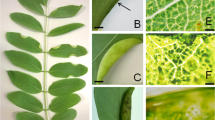Summary
Aseptic tissue cultures of Crown-gall ofScorzonera hispanica L. andHelianthus tuberosus L. have a higher rate of respiration than tissue cultures of the respective healthy tissue. Cultures of healthy tissue ofS. hispanica which have been subjected to high concentrations of auxin (napthalene acetic acid) until they reached an ‘habituated’ stage in which they could grow without addition of the auxin, show an increased respiration similar to that of ‘Crown-gall’ tissue cultures. It is concluded that the respiratory increase shown by ‘Crown-gall’ tissue is not due to the retentive effect of a respiratory toxin alone but due also to a pathogen induced auxin metabolism.
Similar content being viewed by others
References
Allen, P. J. &Goddard, D. R. (1938a) Changes in wheat metabolism caused by powdery mildew; Science88, 192.
Berthelot, A. &Amoureux, G. (1938) Sur la formation d'acide-indoleacétique dans l'action deBacterium tumefaciens sur le tryptophane; C.R. Acad. Sci.206, 537–539.
Dixon, M. (1934) Manometric methods as applied to the measurement of cell respiration and other processes; Cambridge University Press.
Gautheret, R. J. (1959) La Culture des tissus végétaux. Techniques et Réalisations; Masson & Cie., Editeurs. Paris.
Link, G. K. &Eggers, V. (1941) Hyperauxiny in Crown-gall of tomato; Bot. Gaz.103, 87–106.
Maresquelles, C. R. (1928) Sur les échanges respiratoires des plantes attaquées par des Urédinées; C. R. Acad. Sci.187, 247–248.
Maresquelles, C. R. (1930) Etudes sur le parasitisme des Urédinées; Ann. Sci. Nat. Bot., 10e. series,12, 1–127.
Nicholas, M. G. (1913) De l'influence qu'excercent les Fumagines sur l'assimilation chlorophyliene et la respiration; Rev. gén. Bot.25, 385–395.
Nicholas, M. G. (1920) Sur la respiration des plantes parasitées par des champignons; C. R. Acad. Sci.170, 750–752.
Weir, G. M. (1961) The effects of pathogens on glucose catabolism of higher plants; Ph. D. thesis, Univ. of London.
Weir, G. M. (1962). Facultative parasites and host respiration. I. Healthy tissue adjacent to the site of infection. Mycopathol. et Mycol. Appl. XVIII, 3, 184–188.
Yarwood, C. E. (1934b) Effect of mildew and rust infection on dry weight and respiration of excised clover leaves; J. agric. Res.49, 549–558.
Author information
Authors and Affiliations
Additional information
This work formed part of a Ph. D. thesis submitted to the Univ. of London, July 1961.
Rights and permissions
About this article
Cite this article
Weir, G.M. Facultative parasites and host respiration II. Diseased tissue from which the pathogen has been removed. Mycopathologia et Mycologia Applicata 18, 189–193 (1962). https://doi.org/10.1007/BF02051590
Issue Date:
DOI: https://doi.org/10.1007/BF02051590




